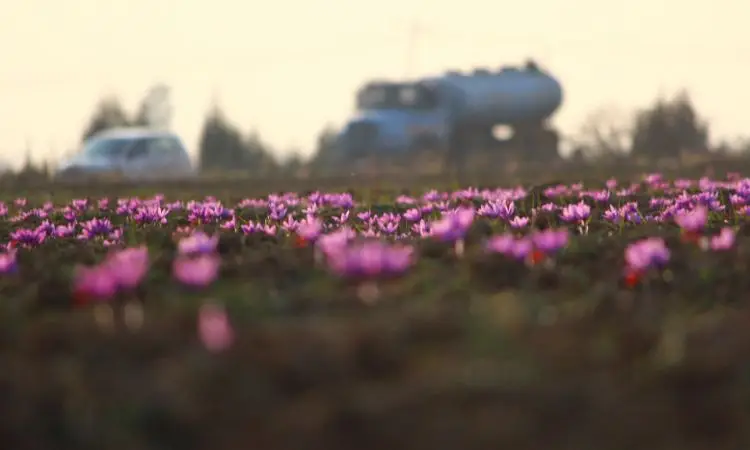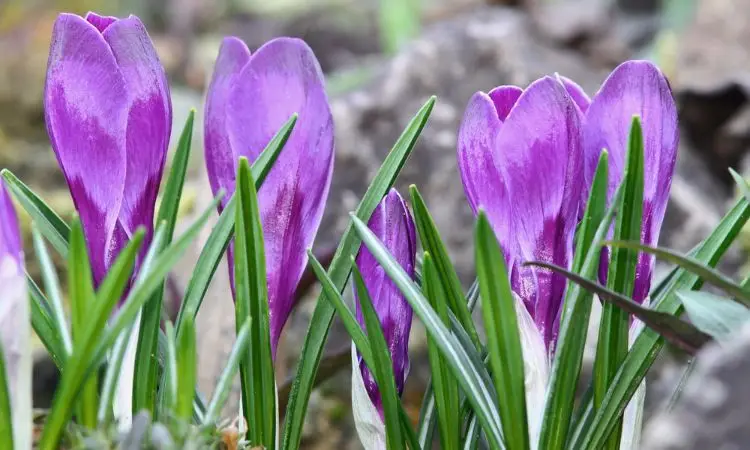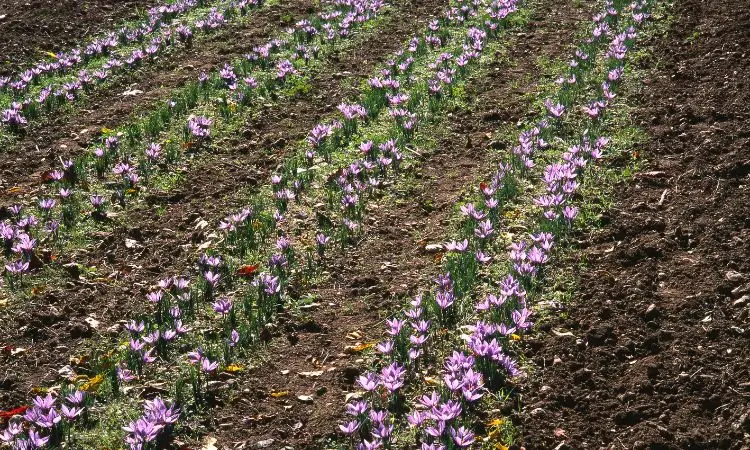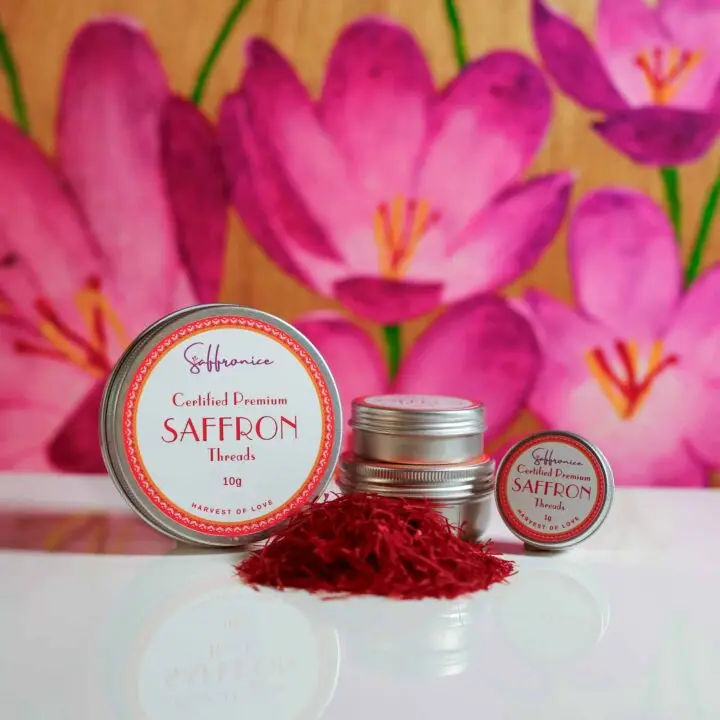Are you curious about the latest developments in saffron cultivation? While Iran continues dominating global production with over 90% market share, revolutionary changes are reshaping how this precious spice is grown. Modern indoor farming utilizing hydroponics and LED lighting enables multiple harvests annually, while traditional methods maintain steadfast advocates. This comprehensive comparison explores both approaches, examining their respective advantages, challenges, and potential futures to determine which path best serves different growers and markets.
The saffron industry stands at a fascinating crossroads where ancient agricultural wisdom meets cutting-edge technology. Understanding both traditional and modern saffron farming methodologies helps growers, investors, and consumers make informed decisions about this valuable commodity.
📌 Quick Answer: Traditional saffron farming (primarily in Iran) uses natural soil, seasonal rainfall, and hand-harvesting methods passed through generations, producing one annual harvest with established quality. Modern indoor farming employs hydroponics, LED lighting, and controlled environments, enabling 3-9 harvests yearly in any location, though with higher initial costs and energy consumption. Traditional methods excel in authenticity and lower operating costs; modern approaches offer consistency, scalability, and climate independence. The optimal choice depends on market goals, capital availability, and regional conditions.
Key Takeaways on Saffron Cultivation
- Iran produces 90%+ of global saffron using traditional methods refined over millennia.
- Traditional farming emphasizes hand-harvesting, natural cycles, and sustainable practices.
- Modern indoor systems enable year-round production with multiple harvest cycles.
- Initial investment differs dramatically: traditional methods require land and labor; modern approaches demand technology and infrastructure.
- Environmental impacts vary: traditional uses minimal inputs; modern uses consume more energy but save water and land.
- Quality standards apply to both methods, with authentication increasingly important.
- Market dynamics favor both approaches for different consumer segments
- Future success likely involves hybrid models combining traditional knowledge with modern efficiency

The Ancient Legacy of Saffron Production
Historical Origins and Cultural Significance
Saffron’s documented history extends over 3,500 years, establishing it as one of humanity’s oldest cultivated crops. This vibrant crimson spice—derived from Crocus sativus stigmas—has transcended mere culinary application throughout history, serving medicinal, ceremonial, and economic roles across civilizations.
Ancient Assyrians first documented saffron cultivation, valuing it for its healing properties and textile dyeing. The sterile saffron crocus, unable to reproduce through seeds, required deliberate human intervention for propagation—a relationship cementing saffron’s position in human agricultural development. Mediterranean civilizations and Persian empires refined cultivation techniques, establishing saffron as both a luxury commodity and a cultural symbol.
Ancient Egyptian texts reference saffron as an aphrodisiac with mythological associations. Persian physician Avicenna (980-1037 CE) documented saffron’s analgesic and anti-inflammatory properties in his comprehensive medical writings, validating traditional medicinal applications through early scientific observation.
Food Scientist’s Note: Historical saffron cultivation inadvertently created optimal genetic selection. Over millennia, farmers naturally selected the most vigorous, aromatic, and colorful specimens for propagation through corm division. This unconscious breeding program concentrated desirable traits—high crocin, picrocin, and safranal content—creating the potent saffron cultivars we know today. Modern cultivation, whether traditional or technological, benefits from this ancient genetic optimization.
Traditional Growing Regions and Methods
Iran’s Khorasan province represents saffron cultivation’s historical heartland, maintaining production methods largely unchanged across centuries. This region currently supplies approximately 90% of global saffron, leveraging unique geographical and climatic advantages supporting optimal Crocus sativus development.
Traditional saffron-producing regions share common characteristics:
- Mediterranean-type climate with distinct seasonal patterns
- Well-drained, slightly alkaline soils
- Hot, dry summers facilitate corm dormancy
- Cool, moist autumns trigger flowering
- Cold winters support vegetative growth
Farmers in these regions rely on natural desert soils and seasonal rainfall patterns, with minimal external inputs. This organic saffron farming approach aligns with modern sustainability principles while maintaining centuries-old agricultural wisdom.
Evolution of Farming Practices Through Centuries
Saffron cultivation evolved gradually through centuries, influenced by political events, economic pressures, and environmental changes. Medieval spice trade routes elevated saffron’s economic importance, with European powers establishing cultivation in conquered territories. The Black Death pandemic (14th century) dramatically increased saffron demand for medicinal applications, driving price increases and expanded production.
Recent geopolitical developments, particularly international sanctions affecting Iran, inadvertently preserved traditional farming methods by limiting access to modern agricultural technologies and international markets. This isolation maintained authentic cultivation practices that might otherwise have modernized, creating interesting implications for contemporary saffron quality and authenticity debates.
Chef’s Professional Tip: Working with saffron from various sources in professional kitchens reveals distinct terroir characteristics between regions, similar to wine. Iranian saffron from Khorasan exhibits deep, almost honeyed aromatics with robust flavor. Spanish La Mancha saffron offers more delicate, floral notes. Greek Kozani saffron presents earthy, hay-like undertones. These differences trace directly to traditional cultivation methods and regional soil/climate variations, characteristics potentially lost in standardized indoor production.
Understanding Modern Saffron Cultivation
Contemporary saffron farming increasingly employs controlled environment agriculture (CEA) technologies, fundamentally altering production parameters and possibilities. Understanding saffron growing challenges helps contextualize why modern methods appeal to certain producers.
Indoor Farming Technologies
Modern saffron cultivation utilizes sophisticated systems mimicking and optimizing natural growing conditions:
Hydroponics Systems:
- Nutrient film technique (NFT) delivers precise mineral solutions
- Deep water culture (DWC) suspending corm roots in an oxygenated nutrient solution
- Ebb and flow systems periodically flood and drain the growing medium
- Aeroponic systems misting roots with nutrient solution
LED Lighting:
- Full-spectrum LED arrays replicating natural sunlight
- Programmable photoperiods control day length precisely
- Energy-efficient alternatives to traditional grow lights
- Adjustable intensity optimizing different growth stages
Climate Control:
- HVAC systems maintain optimal temperatures (15-25°C)
- Humidity regulation prevents fungal diseases
- CO2 enrichment potentially enhances growth
- Air circulation systems mimicking natural wind patterns
Year-Round Production Capabilities
Traditional saffron cultivation yields one annual harvest during the brief autumn flowering period. Modern indoor systems potentially enable 3-9 harvest cycles yearly by manipulating environmental triggers, controlling saffron’s growth phases:
Cycle Manipulation:
- Temperature control triggers dormancy and growth phases
- Photoperiod adjustment inducing flowering
- Nutrient timing optimizing corm development
- Sequential planting creates continuous harvest opportunities
Companies like Veles Farming (Slovakia) and Saffron Tech (various locations) demonstrate the commercial viability of year-round production, though economic sustainability remains under evaluation.
Scalability and Location Independence
Indoor cultivation eliminates geographical constraints, enabling saffron production in:
- Urban environments utilizing vertical farming
- Northern climates are unsuitable for traditional cultivation
- Desert regions without adequate water resources (ironically)
- Regions with contaminated or poor-quality soil
This location independence potentially democratizes saffron production, though high initial capital requirements create different barriers than traditional farming faces.
Traditional Farming Methods in Iran’s Khorasan Region
Iran’s Khorasan province exemplifies traditional saffron cultivation at its finest, maintaining practices refined through 3,000+ years of continuous production. Understanding saffron farming climate requirements explains why this region dominates global production.
Soil and Climate Requirements
Khorasan’s unique combination of soil characteristics and Mediterranean-type climate creates ideal saffron-growing conditions:
Soil Characteristics:
- Sandy loam to loamy texture with excellent drainage
- pH 7.0-8.0 (slightly alkaline), optimizing nutrient availability
- Minimal organic matter (2-4%) prevents excessive moisture retention
- Deep profile allowing extensive root development
- Natural mineral content supporting plant nutrition
Climate Pattern:
- Summer dormancy: Hot (30-40°C), extremely dry
- Autumn flowering: Cool (15-20°C), moderate moisture
- Winter growth: Cold (0-10°C), higher precipitation
- Spring maturation: Warming (10-25°C), declining moisture
This climate pattern precisely matches saffron’s evolutionary requirements, explaining the region’s production dominance.
Natural Growing Cycles
Traditional farmers work with saffron’s natural phenology rather than attempting to override it:
Annual Cycle:
Summer (June-August): Corms rest underground completely dry; fields left fallow
Autumn (September-October): Light pre-flowering irrigation if rainfall is insufficient; monitoring for flower emergence
Flowering (Late October-November): Daily harvest during a 2-3 week bloom window; intensive labor period
Winter (December-February): Leaf growth and corm multiplication; occasional supplemental irrigation
Spring (March-May): Continued growth and maturation; gradual reduction toward dormancy
This natural cycle, requiring minimal intervention, exemplifies sustainable saffron farming principles.
Hand-Harvesting Techniques
Traditional saffron harvesting methods remain unchanged across centuries, requiring exceptional skill and dedication:
Pre-Dawn Harvest:
- Begin before sunrise (4-6 AM typically)
- Pick flowers when closed or barely opening
- Complete harvest before 10 AM, avoiding heat exposure
- Daily picking throughout the bloom period
Flower Collection:
- Gentle hand-picking prevents stigma damage
- Shallow baskets avoid flower crushing
- Immediate transport to processing areas
- Processing within 2-4 hours, maintaining quality
Stigma Extraction:
- Manual separation of three crimson stigmas per flower
- Skilled workers process 600-1,000 flowers hourly
- Removal of yellow styles for premium grades
- Quality inspection throughout processing
This labor-intensive process, requiring 370-470 hours per kilogram of dried saffron, explains the spice’s extraordinary cost while ensuring quality control impossible in mechanized systems.
Technology’s Role in Contemporary Saffron Production
Precision Agriculture Integration
Modern saffron cultivation increasingly employs precision agriculture technologies:
IoT Sensors:
- Real-time monitoring of temperature, humidity, and soil conditions
- Automated alerts for parameter deviations
- Historical data analysis optimizing growing protocols
- Remote access via smartphone applications
AI and Machine Learning:
- Predictive modeling for disease and pest risks
- Optimization algorithms adjusting environmental parameters
- Yield forecasting, improving planning, and marketing
- Computer vision for quality assessment
Automation Systems:
- Automated irrigation based on sensor feedback
- Climate control responding to environmental changes
- Nutrient delivery systemaintaining optimal concentrations
- Lighting schedules automatically adjust for growth stages
Energy Considerations
Modern indoor cultivation consumes significant energy, particularly for lighting and climate control. This energy requirement presents both economic and environmental challenges:
Energy Sources:
- Grid electricity (carbon footprint varies by regional energy mix)
- Solar power integration is reducing fossil fuel dependence
- Hydroelectric power in suitable regions
- Combined heat and power (CHP) systems are improving efficiency
Energy Consumption:
- LED lighting: 20-30 watts per square foot, typical
- HVAC systems: Variable based on climate and insulation
- Water circulation pumps: Modest continuous draw
- Monitoring and control systems: Minimal power requirements
Understanding saffron irrigation needs helps optimize water and energy use regardless of cultivation method.
Economic Comparison: Modern vs Traditional Approaches
Production Costs Analysis
Traditional Farming:
Initial Investment:
- Land acquisition or lease: Variable by region
- Corms: $5,000-$10,000 per hectare
- Basic tools and equipment: $500-$2,000
- Irrigation infrastructure: $2,000-$5,000
- Total initial: $7,500-$17,000 per hectare
Annual Operating Costs:
- Labor (harvest/processing): $15,000-$25,000 per hectare
- Minimal fertilizers/amendments: $500-$1,500
- Water (if supplemental irrigation): $200-$800
- Maintenance: $500-$1,000
- Total annual: $16,200-$28,300 per hectare
Modern Indoor Farming:
Initial Investment:
- Facility construction/retrofit: $100,000-$500,000+
- Hydroponic systems: $20,000-$100,000
- LED lighting: $15,000-$75,000
- Climate control: $10,000-$50,000
- Automation/monitoring: $5,000-$25,000
- Initial costs: $10,000-$30,000
- Total initial: $160,000-$780,000
Annual Operating Costs:
- Energy: $25,000-$75,000
- Labor (reduced but specialized): $20,000-$40,000
- Nutrients/supplies: $5,000-$15,000
- Maintenance/repairs: $5,000-$15,000
- Total annual: $55,000-$145,000
These figures demonstrate modern farming’s significantly higher capital requirements but potential for multiple annual harvests, offsetting elevated operating costs.
Yield Differences
Traditional Farming:
- Single annual harvest: October-November
- Yield: 3-6 kg dried saffron per hectare
- Production is dependent on weather and natural cycles
- Quality variation based on seasonal conditions
Modern Indoor Farming:
- Multiple harvests: 3-9 cycles annually possible
- Potential yield: 15-40 kg per growing space annually
- Consistent production regardless of weather
- Controlled quality through environmental management
While modern methods offer higher theoretical yields, real-world results vary. Many indoor operations struggle to achieve projected yields due to technical challenges and insufficient understanding of saffron’s complex requirements.
Market Value Variations
Saffron pricing reflects multiple factors beyond production method:
Price Drivers:
- Grade/quality (determined by crocin/safranal content)
- Origin (regional reputation affects pricing)
- Certification (organic, geographical indication)
- Processing (all-red vs. styles-included)
- Market positioning and branding
Typical Price Ranges:
- Traditional Iranian premium: $3,000-$5,000 per kg wholesale
- Modern indoor saffron: $2,500-$4,500 per kg wholesale
- Retail prices: $5-$15 per gram ($5,000-$15,000 per kg)
Understanding saffron farming profitability requires analyzing these economic factors comprehensively.

Environmental Impact and Sustainability
Traditional Farming Sustainability
Traditional saffron cultivation demonstrates remarkable environmental sustainability:
Positive Aspects:
- Minimal external inputs (fertilizers, pesticides)
- Natural rainfall dependence reduces water footprint
- Soil health maintenance through minimal disturbance
- Biodiversity support in traditional farming landscapes
- Carbon sequestration in soil organic matter
- Compatible with organic certification standards
Challenges:
- Vulnerable to climate change impacts
- Water scarcity issues in some regions
- Soil degradation potential without proper rotation
- Limited scalability in arid regions
Modern Farming Environmental Considerations
Indoor cultivation presents mixed environmental impacts:
Advantages:
- Reduced water consumption (90% less than traditional in some systems)
- Eliminated pesticide use (controlled environment prevents pests)
- Land conservation (vertical farming multiplies productive area)
- Urban production reduces transportation emissions
- Protection from climate change impacts
Disadvantages:
- High energy consumption (significant carbon footprint unless renewable)
- Manufacturing impact of infrastructure and equipment
- E-waste from electronics and LED systems
- Potential for nutrient pollution from discharge
The environmental comparison depends heavily on energy sources and operational efficiency.
Quality Control and Authentication Methods
Traditional Quality Assessment
Centuries-old techniques for evaluating saffron quality rely on sensory evaluation:
Visual Assessment:
- Deep crimson-red color indicating crocin content
- Thread uniformity suggests consistent processing
- Absence of yellow styles or foreign material
- Characteristic trumpet shape of stigmas
Aromatic Evaluation:
- Distinctive sweet, floral, slightly bitter aroma
- Absence of musty or hay-like off-odors
- Intensity indicating safranal concentration
Taste Testing:
- Characteristic flavor profile assessment
- Bitterness level indicating picrocrocin
- Aftertaste quality and persistence
Experienced dealers and consumers still rely heavily on these traditional methods, though they’re subjective and require expertise.
Modern Testing Techniques
Scientific analysis provides objective quality measurements aligned with saffron quality standards:
Laboratory Analysis:
HPLC (High-Performance Liquid Chromatography):
- Crocin measurement (coloring strength)
- Picrocrocin quantification (flavor intensity)
- Safranal analysis (aroma characterization)
- ISO 3632 standard compliance verification
Spectrophotometry:
- Rapid crocin content estimation
- Color strength measurement
- Field-portable versions enabling on-site testing
DNA Testing:
- Species authentication preventing substitution
- Origin verification supporting geographical indication
- Detection of adulteration with cheaper materials
Blockchain Integration:
- Farm-to-consumer traceability
- Tamper-proof quality documentation
- Enhanced consumer confidence
- Premium pricing justification
Understanding saffron grading systems helps evaluate products from both cultivation methods.
Proper saffron storage methods preserve quality regardless of production origin.
Global Market Dynamics and Trade
The saffron market reflects complex interactions between traditional production dominance and emerging modern approaches. Visit resources about where to buy saffron to understand consumer access.
Market Statistics:
- Global production: ~418 tonnes annually
- Market value: ~$525.7 million (2023)
- Projected growth: 7.3% CAGR through 2030
- Iran’s share: 90% of production volume
U.S. Market Trends:
- 2019 imports: 77,365 kg valued at $15.7 million
- 500% increase from 2009 levels
- Growing demand for natural, health-promoting ingredients
- Price range: $10-$56 per gram retail
Market Opportunities:
- Pharmaceutical applications (depression, eye health)
- Cosmetic industry (skincare, anti-aging products)
- Functional foods and beverages
- Dietary supplements
- Luxury culinary markets
Market Challenges:
- Widespread adulteration and fraud
- Price volatility
- Authentication difficulties
- Supply chain transparency
- Competition from synthetic alternatives
Challenges and Opportunities in Both Farming Methods
Overcoming Labor Intensity
Traditional Approach:
- Requires 370-470 hours per kg of dried saffron
- Harvest demands intensive labor during a brief window
- Processing requires skilled manual work
- Family operations predominate in traditional regions
Modern Solutions:
- Automation potential in indoor environments
- Mechanical stigma extraction under development
- Reduced overall labor needs (though more specialized)
- Continuous harvest spreads labor across the year
Scaling Production
Traditional Limitations:
- Land availability in suitable climates
- Water resources are increasingly scarce
- Labor availability and costs are rising
- Climate change is threatening traditional regions
Modern Scaling Potential:
- Location independence enabling global expansion
- Vertical farming is multiplying productive capacity
- Investment interest from venture capital
- Technology costs are declining over time
Examples like Saffron Tech’s $1 million funding demonstrate investor interest in scaling modern production.
Future-Proofing Approaches
Climate Adaptation:
- Traditional: Vulnerable to changing patterns
- Modern: Protected from external climate impacts
Market Positioning:
- Traditional: Premium positioning on authenticity
- Modern: Consistency and availability advantages
Innovation Potential:
- Traditional: Limited but maintaining cultural value
- Modern: Rapid technological improvements expected
Food Scientist’s Note: The future likely involves hybrid approaches combining traditional knowledge with modern efficiency. Imagine systems where traditional corn selection and processing standards meet precision environment control and automated monitoring. This synthesis could produce saffron with authentic biochemical profiles at scales and consistencies impossible with either method alone.
Frequently Asked Questions
What are the main differences between traditional and modern saffron farming?
Traditional saffron farming relies on natural soil, seasonal weather patterns, and hand-harvesting during a single annual autumn harvest. Modern indoor farming employs hydroponics, LED lighting, and controlled environments, enabling 3-9 harvests yearly in any location. Traditional methods emphasize centuries-old practices and terroir characteristics; modern approaches prioritize consistency, scalability, and climate independence. Initial investment requirements differ dramatically, with traditional farming needing primarily land and labor while modern systems require substantial technology infrastructure.
Which method produces higher-quality saffron?
Quality depends on multiple factors beyond cultivation method. Traditional saffron from established regions often exhibits complex flavor profiles reflecting terroir and time-tested processing methods. Modern indoor saffron can achieve consistent chemical profiles meeting ISO 3632 standards, but may lack nuanced characteristics from natural growing conditions. Both methods can produce premium-quality saffron when properly managed. Authentication testing measures crocin, picrocrocin, and safranal concentrations objectively, with both approaches capable of achieving top grades.
Is modern indoor saffron farming economically viable?
Economic viability remains under evaluation. Modern farming requires initial investments of $160,000-$780,000+ versus $7,500-$17,000 for traditional operations. Operating costs are higher ($55,000-$145,000 annually vs. $16,200-$28,300), but multiple annual harvests potentially offset these expenses. Some operations achieve profitability through premium positioning, pharmaceutical contracts, or value-added products. However, many indoor farms struggle with lower-than-projected yields and unexpected technical challenges. Long-term viability likely depends on technology cost reductions and operational optimization.
Which approach is more environmentally sustainable?
Environmental comparison yields complex results. Traditional farming uses minimal inputs, relies on natural rainfall, and supports biodiversity, ty but faces climate change vulnerability and potential water scarcity. Modern indoor farming reduces water consumption by up to 90%, eliminates pesticides, and conserves land through vertical production, but consumes significant energy (carbon footprint varies by energy source). If powered by renewables, indoor farming may achieve superior sustainability; with fossil fuel electricity, traditional methods likely maintain environmental advantages. Comprehensive lifecycle analysis shows both approaches have sustainability merits depending on specific implementation.
Can traditional and modern methods coexist in the market?
Yes, both methods serve different market segments successfully. Traditional saffron appeals to consumers valuing authenticity, terroir, and cultural heritage, commanding premium prices in gourmet and specialty markets. Modern saffron targets consistent supply needs for pharmaceutical, cosmetic, and food manufacturing applications requiring year-round availability and standardized profiles. Market segmentation, rather than competition, likely characterizes future development. Some producers may adopt hybrid models combining traditional processing with modern grow-out methods, leveraging advantages from both approaches.
What does the future hold for saffron cultivation?
The future likely involves the coexistence and integration of both approaches. Traditional farming regions will maintain cultural and quality leadership, particularly for premium culinary markets. Modern indoor systems will expand, serving pharmaceutical, cosmetic, and consistent-supply industrial applications. Technological advances will reduce modern farming costs, while climate change may challenge traditional regions. Hybrid models combining traditional knowledge with precision agriculture may emerge. Blockchain authentication will increase across both methods. Consumer education about different production methods will improve, creating informed market segmentation rather than viewing approaches as competitive alternatives.
Conclusion
The comparison between traditional and modern saffron cultivation reveals complementary rather than competing approaches. Traditional methods refined across millennia offer authenticity, cultural value, lower initial costs, and proven quality in established growing regions. Modern indoor systems provide consistency, location independence, multiple annual harvests, and climate resilience despite higher capital requirements and energy consumption.
Neither method universally surpasses the other—optimal choice depends on specific circumstances, including capital availability, target markets, regional conditions, and production goals. Traditional farming excels for premium culinary markets valuing terroir and heritage. Modern approaches suit pharmaceutical applications, year-round supply contracts, and regions unsuitable for conventional cultivation.
The future of saffron cultivation likely involves both methods coexisting and potentially integrating. As climate change challenges traditional regions and technology costs decline for modern systems, hybrid models combining ancient wisdom with contemporary efficiency may emerge as optimal solutions. This synthesis could democratize saffron production while preserving the cultural and quality heritage that makes this spice truly precious.
Understanding both approaches empowers growers, investors, and consumers to make informed decisions aligned with their values and objectives in the evolving world of saffron agriculture.



